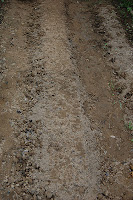Another major activity at the farm is the rearing of fish, On 1st of June, a new batch of fish was placed in the ponds. The baby fishes (10,000 keli and 15,000 red tilapia) were about 2 inches long and in the month that they have been in the pond, I am amazed at the growth, especially the keli.

I started them out with the starter feed with high protein and to date, the loss has been almost negligible. They are fed strictly fish pellets and leaves from tapioca and
keladi. A definite no-no is any carcasses, human or animal wastes, or animal innards. Whilst this means that the cost of feeding them is higher but I believe in producing quality tasty fish that doesn't have a funny taste or smell to it.

Another key element is the quality of water - to ensure good oxygen content as well as keeping the fish waste level to a minimum. Alhamdulillah, the investment of laying 3 inch polypipe from the source up river ensures a good constant supply of water into the pond resulting in continuous inflow and outflow. Definitely no smelly, stagnant water so it provides a beautiful landscape feature to the farm.
I have separated the keli and tilapia but somehow a few of the keli has managed to get into the tilapia pond. There are a few other fishes that have appeared in the tilapia pond - river fish as well as haruan. I guess I will know what else has appeared in the pond when I drain and harvest the tilapia.
In order to gain more knowledge into the rearing of the fish, I have attended courses with Jabatan Perikanan as well as visited some other fish farmers - the quest for knowledge never ends.
.JPG)
I love feeding times - the first 3 weeks I fed them 2 times a day and then increased it to 3 times a day with the feed calculation based on 2% of the estimated total body weight of the fish. After the second week, I changed the feed to be specific feed for the type of fish - keli feed for keli and tilapia feed for the tilapia. When the keli is feed, there is this furious rush of feeding activity and you can hear the sound of the water as they attack the feed, The tilapia also rush for the food but it is less aggressive when feeding.
This week, we will be categorizing the keli by size and separating them. The rate of growth is different although they were all about the same size when introduced into the pond. The larger size will be placed in the holding pond ready for harvest as I expect the first harves will occur by end of month if not sooner.
.JPG)
The tilapia on the other hand is targetted to be harvested at the end of October.
The next challenge I face is marketing the fish so I will have to draw from my corporate experience. InsyAllah, this effort will be successful. The journey continues......
 I was first introduced to this leave when I attended MAHA 2010 and at one of the stalls they had sayur lemak lumai. Later, I found out that they were growing at the farm. This plant belongs to the terung or solanaceae family although the fruit is not eaten especially the unripe fruit and the leaves are eaten either raw or cooked. In Indonesia, it is also known as Ranti.
I was first introduced to this leave when I attended MAHA 2010 and at one of the stalls they had sayur lemak lumai. Later, I found out that they were growing at the farm. This plant belongs to the terung or solanaceae family although the fruit is not eaten especially the unripe fruit and the leaves are eaten either raw or cooked. In Indonesia, it is also known as Ranti. This plant produces tiny white flowers which turns into a dark purplish black berry which contains many tiny seeds. These seeds can be used to propagate new plants by squeezing out the seeds and putting it into soil, lightly covering the seeds. However, once you have seeded it, this plants do fare well when moved and transplanted to a different location. It prefers a semi-shade location and flourishes in moist but not soggy ground.
This plant produces tiny white flowers which turns into a dark purplish black berry which contains many tiny seeds. These seeds can be used to propagate new plants by squeezing out the seeds and putting it into soil, lightly covering the seeds. However, once you have seeded it, this plants do fare well when moved and transplanted to a different location. It prefers a semi-shade location and flourishes in moist but not soggy ground.










.JPG)



.JPG)
.JPG)